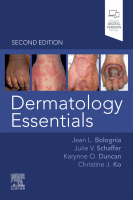Physical Address
304 North Cardinal St.
Dorchester Center, MA 02124

The skin is normally colonized by hundreds of species of bacteria as part of the cutaneous microbiota (flora). These organisms help prevent skin infection by competing with pathogenic microorganisms. Skin infection with bacteria may be a primary problem (e.g. impetigo)…

Introduction The anatomy ( Fig. 60.1 ), normal cutaneous findings, and benign lesions of the anogenital area ( Table 60.1 ) should be appreciated before addressing diseases in this area. Table 60.1 Normal findings and benign lesions of the anogenital…

In addition to common benign lesions such as bite fibromas and mucoceles, oral findings can represent clues to the diagnosis of skin disorders (e.g. lichen planus, early pemphigus vulgaris) or cutaneous signs of systemic disease ( Table 59.1 ). Table…

The nail matrix, which is the growth area, has proximal and distal components ( Fig. 58.1 ). – The proximal nail matrix forms the top (surface) of the nail plate – The distal nail matrix forms the underside of the…

Definitions Hypertrichosis : excessive hair growth on any area of the body, beyond what is normally expected for a patient’s demographic group. Hirsutism : excessive terminal hair growth in women or children in a pattern typically seen in adult men.…

In a normal scalp, 90–95% of hairs are in anagen phase, 5–10% in telogen phase ( Fig. 56.1 ). About 50–100 hairs normally shed daily. Alopecias can be categorized as diffuse vs circumscribed, patterned vs non-patterned, and non-scarring vs scarring…

Definitions Hyperpigmentation : a term used to describe disorders characterized by darkening of the skin; encompasses hypermelanosis. Hypermelanosis : a more specific term that denotes an increase in the melanin content of the skin; typically due to an increase in…

Introduction/Definitions Leukoderma and hypopigmentation : areas of skin are lighter in color than uninvolved skin, due primarily to a decrease in melanin; decreased blood supply to the skin (e.g. nevus anemicus) can be another cause of leukoderma. Hypomelanosis : an…

Developmental anomalies are a diverse group of congenital disorders that result from faulty in utero morphogenesis. When they affect the skin, developmental anomalies can range in severity from isolated minor physical findings to potentially life-threatening conditions or cutaneous signs of…

This chapter discusses genetic skin diseases that are not covered in other chapters, including conditions featuring extracutaneous tumorigenesis, enzyme deficiencies, premature aging, and ectodermal dysplasia. Disorders Featuring Extracutaneous Tumorigenesis Cowden Syndrome and OtherForms of PTEN Hamartoma Tumor Syndrome Spectrum of…